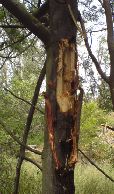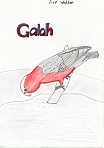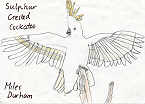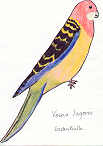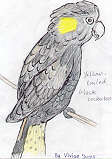
YELLOW-TAILED BLACK COCKATOO
Calyptorhynchus funereus
Height 660 mm (24")
Large dark bird with yellow ear and tail band. Moderately common in Ash and foothill forests in pairs and small noisy flocks. Not recorded in the 1994 fauna survey of Herring Island.
Feeds on seeds, fruits and nectar. It also rips into trees to get at grubs.. (picture at right.).
Lays two white eggs in a nest located in a hole in a tall tree.
Breeding season: April to October.
Illustration by Vivian Duong
